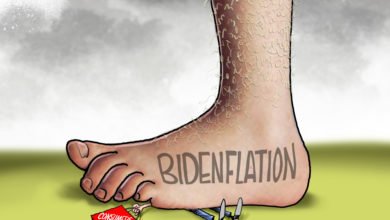Americans Are Getting Crushed By Debt — And It May Just Get Worse |

Americans are currently beset by record levels of debt, and their financial burden could further increase thanks to rising interest rates, inflationary prices and the looming end of the student loan moratorium.
Total household debt climbed to a new high in the second quarter of 2023, reaching $17.06 trillion, with credit card debt exceeding $1 trillion, according to the Federal Reserve Bank of New York. As interest rates stay high, costs continue to rise for expenses like housing and cars, and student loan payments resume, the amount of debt may rise, according to economists who spoke to the Daily Caller News Foundation.
“The amount of debt outstanding, and in particular the surpassing of the $1 trillion mark, is significant and worrisome,” Peter Earle, an economist at the American Institute for Economic Research, told the DCNF. “It owes to a combination of several factors. The initial response to the pandemic, which prominently included the Fed setting policy (interest) rates at essentially zero for several years, made the amount of credit and the price of taking on debt extraordinarily cheap.”
Interest rates for all credit lines are facing upward pressure following the Federal Reserve hiking the federal funds rate eleven times since March 2022, bringing the current rate to a range of 5.25% and 5.50%. Rates were hiked in an effort to combat inflation, which remained elevated in July at 3.2%, ticking up from 3.0% in June but down from 9.2% in June 2022.
“Interest rates on credit cards, car loans, mortgages, and other forms of debt have been shooting up, making the servicing of debt taken at low prices more expensive presently,” Earle told the DCNF.
This pressure could worsen if the Fed decides to raise its federal funds rate once again, with Federal Reserve chair Jerome Powell hinting at the Jackson Hole Economic Symposium that rates will be raised if market conditions do not soften.
“Record levels of outstanding credit card debt is concerning, especially in a time of rising interest rates,” Michael Faulkender, chief economist and senior advisor for the Center for American Prosperity, told the DCNF. “Overall debt burdens for many households are manageable because they locked in record low mortgage rates in 2020 and 2021.”
Future inflation could continue to worsen the debt situation if real wages fail to keep up, increasing real costs for American consumers and thereby putting Americans further into to debt to pay for basic goods. Powell predicted, following the July Federal Open Market Committee Meeting, that inflation would not return to the normal level of 2% until 2025, even with the high interest rates.
“For younger households facing rising rent, restart of student loan payments, and rising credit card debt burden, they are struggling,” Faulkender told the DCNF. “This is exacerbated by the fact that wages have not kept up with inflation and many households are burning through the savings they accumulated during the pandemic. For these households, Bidenomics is a complete bust.”
.@TuckerCarlson and I discuss how half of all Americans live paycheck to paycheck and U.S. credit card debt hits a record $1 trillion. Too many people in this country feel they have been completely abandoned by both parties. It's time to fix this. #Kennedy24 pic.twitter.com/eeFwjpsaUT
— Robert F. Kennedy Jr (@RobertKennedyJr) August 27, 2023
The total balance for student loans fell in the second quarter of 2023 by $35 billion, coming down to $1.57 trillion, according to the New York Fed. The decrease follows a more than three-year hold on payments issued during the COVID-19 pandemic, with interest on balances resuming in September and payments resuming in October, meaning younger Americans could face increased expenditures and an inability to pay off their debts unless personal spending or saving is reduced.
“The return of student loan payments will have a profound impact on many Americans,” Earle told the DCNF. “With one trillion in debt out there and having not had to pay for over three years, tens of millions of Americans will suddenly have to come up with what amounts to another car payment each month. I suspect the effect upon US consumption will be profound.”
Auto loan balances increased by $20 billion for the second quarter of 2023, bringing the volume of newly originated auto loans to $179 billion, according to the New York Fed. Prices have risen for new cars, with only one new model released in 2023 selling for less than $20,000, as opposed to a dozen new models five years ago, with 60-plus-day delinquencies on prime auto loans rising from 0.41% to 0.49% over the course of a year ending in June and sub-prime delinquencies rising from 4.89% to 5.37% over that same period.
“The statistics on auto loan delinquencies are surprising, as they are not only rising but already above pre-Covid levels,” Earle told the DCNF. “And many of those people are facing the return of monthly student loan payments in 30 to 60 days. Add to that persistently high shelter costs and the recent spike up in gasoline prices, and it’s clear that going into September 2023, things are beginning to get tight for the average U.S. consumer.”
Mortgage rates have recently surged to a 20-year high, with interest rates for a 30-year fixed-rate mortgage peaking at 7.23% in August but coming down to 7.18% by the end of the month, according to mortgage giant Freddie Mac. Following the high rates, Americans are opting not to buy homes, with only 4,160,000 existing homes being sold for the month of June, which is far lower than the consistent 6 million existing homes sold per month in 2021.
The economy has had a series of negative indicators recently, with yearly real Gross Domestic Product being revised down for the second quarter and job gains cooling, meaning the Fed may not raise the federal funds rate in September, halting the speed at which interest rates are rising and providing some relief to Americans with debts.
Content created by The Daily Caller News Foundation is available without charge to any eligible news publisher that can provide a large audience. For licensing opportunities of our original content, please contact licensing@dailycallernewsfoundation.org



